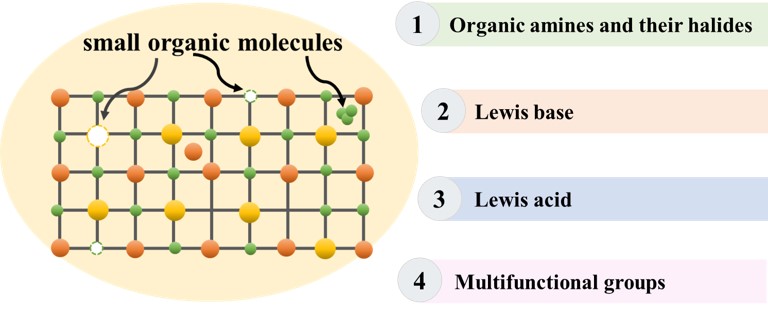 Open Access
Open Access
REVIEW
Recent Progress of Surface Passivation Molecules for Perovskite Solar Cell Applications
1 College of Chemistry and Chemical Engineering, China University of Petroleum (East China), Qingdao, 266580, China
2 School of Materials Science and Engineering, China University of Petroleum (East China), Qingdao, 266580, China
3 Shandong Energy Group Co., Ltd., Jinan, 250000, China
* Corresponding Authors: Teng Zhang. Email: ; Xiyou Li. Email:
Journal of Renewable Materials 2023, 11(4), 1533-1554. https://doi.org/10.32604/jrm.2022.023192
Received 14 April 2022; Accepted 20 May 2022; Issue published 01 December 2022
Abstract
Due to the solution processable nature, the prepared perovskite films are polycrystalline with considerable number of defects. These defects, especially defects at interface accelerate the carrier recombination and reduce the carrier collection. Besides, the surface defects also affect the long-term stability of the perovskite solar cells (PVSCs). To solve this problem, surface passivation molecules are introduced at selective interface (the interface between perovskite and carrier selective layer). This review summarizes recent progress of small molecules used in PVSCs. Firstly, different types of defect states in perovskite films are introduced and their effects on device performance are discussed. Subsequently, surface passivation molecules are divided into four categories, and the interaction between the functional groups of the surface passivation molecules and selective defect states in perovskite films are highlighted. Finally, we look into the prospects and challenges in design noble small molecules for PVSCs applications.
Graphic Abstract

Keywords
Cite This Article
 Copyright © 2023 The Author(s). Published by Tech Science Press.
Copyright © 2023 The Author(s). Published by Tech Science Press.This work is licensed under a Creative Commons Attribution 4.0 International License , which permits unrestricted use, distribution, and reproduction in any medium, provided the original work is properly cited.


 Submit a Paper
Submit a Paper Propose a Special lssue
Propose a Special lssue View Full Text
View Full Text Download PDF
Download PDF Downloads
Downloads
 Citation Tools
Citation Tools